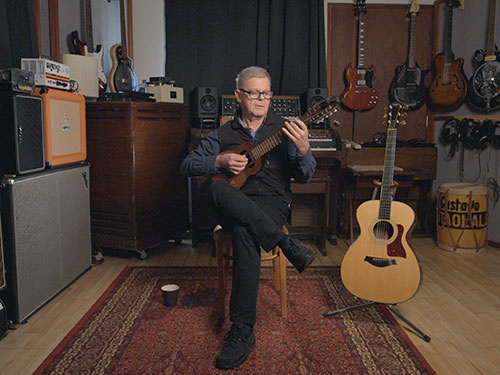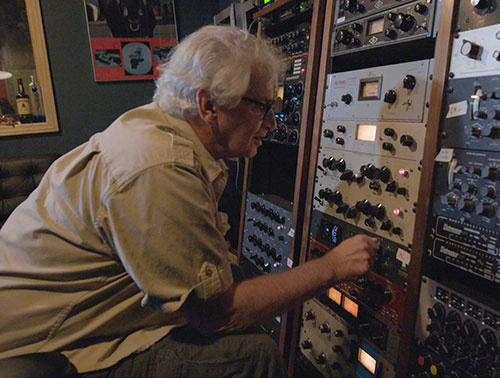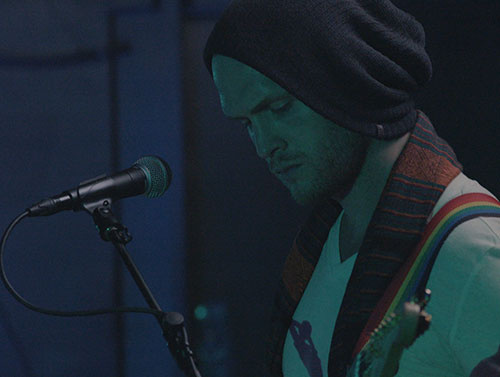‘The Art of Listening’ (courtesy of New Bay Media)
5/02/2016 7:45 PM Eastern
Author: Thomas Kenny

Composer/arranger/multi-instrumentalist Gustavo Santaolalla. Courtesy The Art of Listening
It is fitting that producer Andrew Scheps is featured prominently in the new music documentary, The Art of Listening, advocating the experiential benefits of listening to hi-res music and encouraging its distribution. A couple of years ago, Scheps delivered his touring presentation called “Lost in Translation” at Fantasy Studios in Berkeley, Calif., where he broke down the compression schemes in modern delivery formats.
Michael Coleman, a young Bay Area filmmaker, was in the audience and later conducted an interview with Scheps. Neither knew then that the interview would inspire what became, after a few twists and turns, The Art of Listening.
Coleman, an audio graduate of Ex’Pression College of Digital Arts in the early 2000s, spent a year interning with producer Jack Douglas before turning to filmmaking. He’s always had an ear for sound while behind the camera, and has devoted much of his production work to taking viewers inside the creative process. A decade ago, he launched the popular site soundworkscollection.com, with an emphasis on audio post and music composition. In recent years, he’s teamed up regularly with filmmaker Emmanuel Moran, and the two began conceiving of a project all about hi-res audio.
“We were at first interested in what hi-res actually means and do people care,” Coleman says. “Is there a way to get people to think about what they’re listening to? To us it was no different than thinking about what you put in your body when you eat food. But when we went down that path, it somehow turned really negative and heavy-handed. We did a complete 180 and said that this needs to be inspiring.”

Producer Jack Douglas, who talks of listening to subtle changes in mic position and outboard effects. Courtesy The Art of Listening
While still figuring out direction, the two went ahead with interviews in Los Angeles, New York and the Bay Area, capturing engineers, producers and composers. The first real interview after Scheps was Mark Weinstein, founder of Amoeba Records. Then Hans Zimmer, Steve Vai, Tim Westerberg and 10 or 12 others. At some point along the way, they realized that “chasing the fidelity conversation,” as Coleman calls it, was a dead end. Convenience had won out for now. So they started thinking about listening, in the broadest sense of the term.
“We thought about listening as so many types of experiences,” Coleman says. “The bare minimum was simply giving music your time and attention, to show people that there is value in spending time with music. So much of a person’s relationship to music is based on their habits, their household, how they were raised. We wanted to show that the fundamentals are that you love music and you want to spend more time with it. As a listener, you’re a part of the artist’s community.”
At the same time they were changing direction, the filmmakers received financing from Sony Electronics, which meant two things: They could now explore an hour-long feature-length documentary, and they could shoot 4k with the Sony FS7.
Coleman and Moran hooked up with producer Sebastian Weinberg and set out to gather more interviews, finding a wonderful cast of characters, from luthiers and singer songwriters, to Dave Smith and David Chesky; from Gabriel Roth to Kamasi Washington; from Antonio Sanchez to Gustavo Santaolalla. It’s the juxtaposition of big names and no-names, instrument makers and artists, that gives the film its power. All have a relationship to listening and to music, no matter their craft.
The film is scored beautifully and soothingly, like a slow wave over a big ocean, by Christopher Willits, a Bay Area composer and artist who also speaks eloquently in the film. It is also punctuated by live performances, many of them impromptu, all of them reinforcing the idea of listening. It opens at the famed Bluebird Café, with an intimate audience surrounding a band 360 degrees on the floor, which is about as close as you can get to a true music listening experience.

The film’s composer, Christopher Willits, performing live. Courtesy The Art of Listening
The Art of Listening was mixed in 5.1 at Skywalker Sound by sound designer/re-recording mixer Steve Boeddeker, whose list of credits includes Bridge of Spies, Beasts of the Southern Wild and Pixels, among countless others. Coleman wanted to work with him because he is a musician, too.
“It was mixing for feel, really,” Coleman explains. There are no real sound effects in the traditional sense, though he did play with bringing music a little bit off the front wall to the sides. We wanted it to be in 5.1 because it will eventually be playing festivals and VOD.”
The Art of Listening team held a premiere in March at SXSW, accompanied by Willits in live performance. The film has been submitted to festivals worldwide and plans are underway to hold screenings in select cities. If it’s headed your way be sure to give it a listen.
For more, visit theartoflisteningfilm.com.
